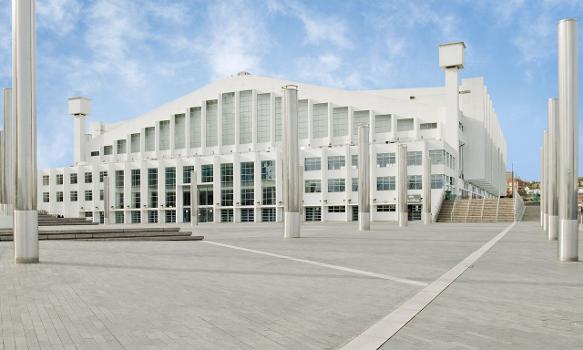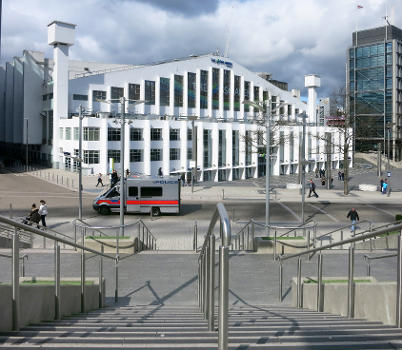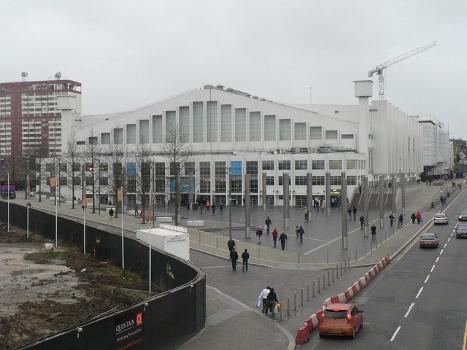General Information
| Other name(s): | Empire Pool; SSE Arena, Wembley; OVO Arena Wembley |
|---|---|
| Beginning of works: | November 1933 |
| Completion: | 25 July 1934 |
| Status: | in use |
Project Type
| Architectural style: |
Art Deco |
|---|---|
| Function / usage: |
original use: Swimming pool / aquatic center current use: Multipurpose hall |
Awards and Distinctions
| 1976 |
for registered users |
|---|
Location
| Location: |
Brent, London, England, United Kingdom |
|---|---|
| Address: | Arena Square, Engineers Way |
| Part of: | |
| Coordinates: | 51° 33' 28.99" N 0° 16' 58.19" W |
Technical Information
There currently is no technical data available.
Excerpt from Wikipedia
Wembley Arena /ˈwɛmbli/ (originally the Empire Pool and, since 1 July 2014, currently known as The SSE Arena, Wembley for sponsorship reasons) is an indoor arena in Wembley, London. With 12,500 seats, it is London's second-largest indoor arena after The O2 Arena, and the seventh-largest in the United Kingdom.
History
The Empire Pool (also known as Empire Pool and Sports Arena) was built for the 1934 British Empire Games at Wembley, by Arthur Elvin, and originally housed a swimming pool, as reflected by its name. The pool itself was last used for the 1948 Summer Olympics. The building is used for music, comedy, family entertainment and sport.
It was designed by the engineer Sir Owen Williams, without the employment of an architect. Williams built a unique structure, with cantilevers meeting in the middle, thus avoiding the need for internal pillars. He also used high quality concrete, meaning that it has aged far better than many more recent concrete buildings.
Work on the Empire Pool began in November 1933, and it was opened on 25 July 1934 by the Duke of Gloucester. At the time it had the largest span of any similar structure in the world. As with the Stadium, construction was supervised by R.J. Fowler, Wembley's chief building inspector.
Elvin introduced ice hockey to the new Empire Pool in October 1934. In 1976, the Empire Pool was awarded Grade II Listed status, recognising it as a building of special architectural interest, technological innovation and virtuosity. On 1 February 1978, the Empire Pool was renamed Wembley Arena.
When the venue was known as the Empire Pool, it hosted the annual NME Poll Winners Concerts during the mid-1960s. Audiences of 10,000 viewed acts like The Beatles (who performed there three times), T. Rex (whose Ringo Starr-directed documentary film Born to Boogie is centered on a 1972 concert at the Empire Pool); David Bowie, Cliff Richard & The Shadows, The Monkees, The Hollies, Dusty Springfield, Joe Brown & the Bruvvers, The Rolling Stones, Pink Floyd, (who played there on their 1977 "In the Flesh" tour). The Eagles on their Hotel California 1978 tour, The Grateful Dead, Dire Straits, who played there on their "Brothers In Arms" tour in 1985 and "On Every Street" tour in 1991, Status Quo, The Who, Dave Dee, Dozy, Beaky, Mick & Tich, were among many others. The individual performances were then finished by a famous personality joining the respective performer on stage and presenting them with their award. The Beatles were presented with one of their awards by actor Roger Moore and Joe Brown was joined on stage by Roy Orbison, to present him with his own award. These ceremonies were filmed, recorded and later broadcast on television.
Renovation
The venue was renovated, along with Wembley Stadium, as part of the early-21st-century regeneration of the Wembley Park area. The arena was temporarily closed in February 2005, with refurbishment costing £35m. Concerts were held at the neighbouring temporary 10,000-seat Wembley Arena Pavilion instead. The new arena opened to the public on 2 April 2006, with a concert by the English electronic-music band Depeche Mode. The temporary pavilion was later moved to Malta Fairs & Convention Centre (MFCC) in Attard, Malta, where it opened in December 2006.
In September 2013, it was announced that AEG Facilities had signed a 15-year contract to operate the arena.
The building was renamed The SSE Arena on 1 June 2014 after SSE plc bought the naming rights to the venue for 10 years.
Square of Fame
With the reopening of Wembley Arena in 2006, a "Square of Fame" area has been created in front of the arena. Similar to the Hollywood Walk of Fame, notable Wembley Arena performers are invited to have bronze plaques imprinted with their names and handprints. The first star to have a plaque was Madonna, on 1 August 2006. On 9 November 2006, Cliff Richard added his handprints to the Square. Rick Parfitt and Francis Rossi, of Status Quo, unveiled a plaque, with one of each of their handprints, on 16 December 2006. On 9 January 2007, Kylie Minogue included her handprints, on the final day of the London leg of her Showgirl Homecoming Tour.
Seven time World Snooker Champion Stephen Hendry added his handprints on 21 January 2007. International country superstar Dolly Parton unveiled her plaque, on the final night of her UK tour, on 25 March 2007. Canadian musician Bryan Adams unveiled his plaque, on 10 May 2007, just before his 25th appearance at the venue. Just three days later, singer Lionel Richie was presented with his plaque on 13 May 2007, after another sold out performance at the arena. Irish boyband Westlife unveiled their plaque on 28 March 2008, after 27 sell-out shows, in the space of 10 years. They have sold 250,000 tickets. All four members, Shane Filan, Nicky Byrne, Kian Egan and Mark Feehily were presented with a cast of their hands, which can also be seen in the Square of Fame. Alice Cooper added his handprints in 2012 as the only solo artist to have headlined at the venue in the past five consecutive decades.
Transport
Wembley Arena is served by Wembley Park station on the London Underground via Olympic Way, and Wembley Central station via the White Horse Bridge.
Train services are operated by Chiltern Railways from Wembley Stadium station to London Marylebone and Birmingham. London Buses route 92 stops directly outside the arena. Wembley Central station is located nearby on High Road and is served by London Overground, London Underground, Southern and West Midlands Trains services.
The onsite parking facility is shared with Wembley Stadium, essentially being the open air surface parking surrounding the eastern flank of Wembley Stadium and the multistorey car park. These are called Green Car Park and Red Car Park respectively. There is disabled parking available onsite, at the Green Car Park, at a reduced rate but on a first come first served basis.
Text imported from Wikipedia article "Wembley Arena" and modified on July 23, 2019 according to the CC-BY-SA 4.0 International license.
Participants
- Sir Owen Williams (engineer)
Relevant Web Sites
- About this
data sheet - Structure-ID
20033480 - Published on:
01/12/2007 - Last updated on:
05/01/2025








